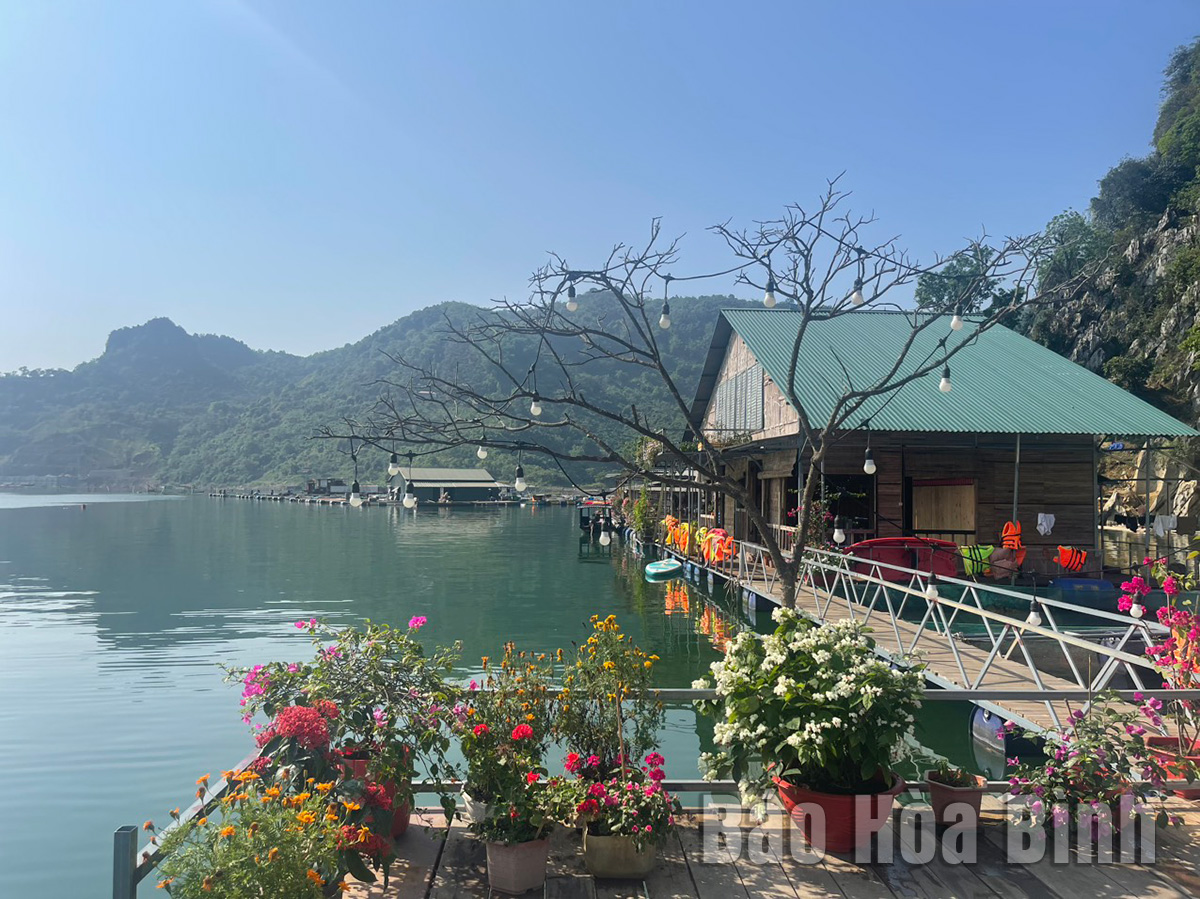
(HBO) - Hoa Binh reservoir in the northern province of Hoa Binh has a capacity of more than 9 billion m3 and rich aquatic resources. The area is considered a precious treasure of aquatic life, and it is likened to Ha Long Bay on land, attracting a large number of tourists
In 2016, the Prime Minister approved a master plan to develop the reservoir into a national tourism area until 2030. Taking advantages of the water surface and majestic natural landscape, many local households have developed fish cage farming associated with tourism development, bringing high economic efficiency.
Homestay of Nguyen Van Binh’s family in Thai Binh ward of Hoa Binh city.
Nguyen Van Binh in Thai Binh ward of Hoa Binh city has been engaged in fishing and cage farming for more than two decades on the lake. Currently, his family has seven cages for raising fish, mainly salmon, perch and carp. However, in recent years, when the market has begun to saturate and especially due to impacts of the COVID-19 epidemic in 2021 – 2022, affecting fish prices, Binh decided to turn his fish raft into a floating homestay to serve tourists. On average, his homestay welcomes some 400 visitors a month in summer, helping to generate a stable source of income.
In recent years, many households in the area have developed the model of fish cage farming in combination with eco-tourism development. Currently, nearly 20 households in Voi and Thau residential areas and some hamlets in the lake-bed area of Thung Nai (Cao Phong), Vay Nua, Tien Phong (Da Bac) communes have registered to operate this type of business.
There are now nearly 5,000 fish cages in the Hoa Binh hydropower reservoir, with an average annual output of nearly 10,000 tonnes. Fish cage farming associated with tourism development is currently the direction many households are aiming to awaken the potential and strengths of the Hoa Binh lake.
According to Nguyen Huy Nhuan, Director of the provincial Department of Agriculture and Rural Development, in order to both sustainably develop the fishery industry and tourism in the area, the department has directed the Fisheries Sub-Department to guide fish cage households and communes continue to develop effectively breeding of aquatic species with economic values associated with ecological environment protection. In particular, households are asked to focus on specialty fish in the lake, and apply VietGAP farming process, science and technology to aquaculture production in order to increase added valuesand reduce costs.
The province has also encouraged and supported the development of aquaculture in association with tourism, educational activities, eco-tourism and sightseeing tours./.
A diverse chain of eco-tourism and resort destinations concentrated in Hoa Binh city and the districts of Tan Lac, Da Bac, and Luong Son… Along with the launch of several key high-quality resort tourism projects, these developments have reshaped the landscape and enhanced the appeal of Hoa Binh as a travel destination.
Boasting diverse terrain, a mild climate, and rich natural resources, Cao Phong district is increasingly asserting its place on Vietnam’s tourism map, attracting both domestic and foreign visitors. The district is renowned for its stunning landscapes, majestic mountains, a crystal-clear hydropower lake, and the unique cultural identity of local ethnic groups.
With its pristine landscapes, unique cultural heritage of Muong ethnic minority, and an expanding range of visitor experiences, Tan Lac district of Hoa Binh has fast become a captivating destination for both domestic and international tourists.
Until now, Sung village in Cao Son commune, Da Bac district remains the only Dao ethnic community in Hoa Binh province to develop a community-based tourism model. Beyond its untouched natural landscapes, cultural identity serves as the cornerstone attraction for visitors.
Alongside the diverse cultural identities of the Kinh, Muong, Tay, Thai, Dao, and Mong ethnic people, Hoa Binh province is also renowned as the "capital" of the northwestern Vietnamese cuisine, offering unique and distinctive dishes. At festivals, during Lunar New Year (Tet), or on significant family or community occasions, special dishes are prepared, leaving a lasting impression on visitors.
A Phong Linh (Yellow Tabebuia) flower garden in Thang village, Thach Yen commune, Cao Phong district is currently in full bloom, drawing a large number of visitors.



